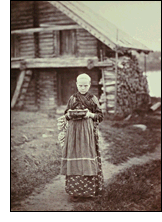 At
the turn of the century, the municipality of Kontokki included Kostomuksha,
the villages around Lake Kiitehenjärvi, as well as the villages
of Vuokinsalmi, Saarijärvi and Niskajärvi near the Finnish
border. The eastern boundary of Kontokki extended beyond Lake Kenttijärvi.
The population of the municipality in 1907 was 1,872. At
the turn of the century, the municipality of Kontokki included Kostomuksha,
the villages around Lake Kiitehenjärvi, as well as the villages
of Vuokinsalmi, Saarijärvi and Niskajärvi near the Finnish
border. The eastern boundary of Kontokki extended beyond Lake Kenttijärvi.
The population of the municipality in 1907 was 1,872.
Kontokki was not the largest village in the area; that distinction
belonged to Akonlahti. Kontokki had 35 houses and 230 people. Kostamuksha,
too, had a higher population than its neighbor, although it had
fewer houses.
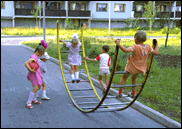  Kontokki
was not a major bardic village, either. Poems were collected there
by Lönnrot (1837), Europaeus (1845), Borenius and Genetz (1872)
and Juvelius (1886). They all visited Kostomuksha as well, as did
the researchers and collectors that came after them. Kontokki
was not a major bardic village, either. Poems were collected there
by Lönnrot (1837), Europaeus (1845), Borenius and Genetz (1872)
and Juvelius (1886). They all visited Kostomuksha as well, as did
the researchers and collectors that came after them.
Lönnrot describes his visit to Kontokki as follows:
I walked alone 15 km to Kontokki, to which there was a good
trail. I stopped to see Sallinen, one of whose brothers is living
near Tornio in Finland. Sallinen had been a Lutheran for some
time, but now he had converted back to the Orthodox faith. He
deserted the army near the Persian border. Six houses in Kontokki.
Spent the night there.
None of the other visitors to Kontokki had much to tell about
the village or the villagers. Inha at least had something to say:
"The village is spread out along the shores of its big lake.
In a sense, its graveyard was even more curious than that in Kostomuksha;
all the trees were petrified and dead yet still standing. A woodpecker
clacked on the tree; the wind whistled; loose strips of bark flapped
in the wind; and rotting, cracking branches jutted out with tufts
of beard moss on them."
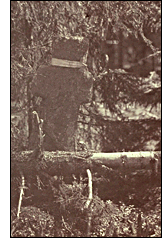 Inha
wrote the following about the graveyard in Kostomuksha, to which
he had compared that in Kontokki: Inha
wrote the following about the graveyard in Kostomuksha, to which
he had compared that in Kontokki:
Evening was already upon us when we reached the shore out
of the wind and saw a high stand of spruce in the fading light
of day. The trees were like a spectacular bush on the dark land.
There were gray houses around it that one could hardly distinguish
from the ground. This was the village of Kostomuksha, and the
stand of spruce marked its graveyard.
I went back there the following morning since I had never seen
such a solemn and majestic stand of spruce. They were old trees
and extraordinarily tall. Some had fallen through wind or age
but had been left where they were, since custom dictates that
one cannot touch a tree in a graveyard with an axe or a knife.
Everything must be allowed to grow and fall as nature deems fit.
Sparre also describes at great length what he called that "picturesquely
untamed" graveyard, a site that later proved to be of archeological
interest as well.
Discoveries in the Kostomuksha graveyard
Before the site of the village of Kostomuksha and its graveyard
were covered by the sludge basin of the Kostomuksha mining complex,
archaeologists had some time to conduct excavations. The graveyard
proved to be very old indeed, with three layers of graves being
uncovered. Interesting finds included birch bark coffins and the
burial of dogs with their masters. One dog even had a silver cross
around its neck. The oral tradition telling of the giants of Viena
gained some credence when a number of graves were found of men over
two meters tall.
When Lönnrot came to Kontokki, he spent four days in Kostomuksha
- some 10 houses at the time - and recorded poems, fairy-tales and
proverbs. The esteemed Kalevala researcher Väinö Kaukonen
gave the following appraisal of Lönnrot's notes: "[His]
notes from Kostomuksha were important - first-hand folk poetry material
for the second edition of the Kalevala. And this applies to the
Kanteletar as well."
Other valuable materials on the area include Inha's photographs
of a wedding on Pentecost and the description of an 1892 wedding
by Sparre.
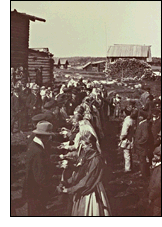 Stroitša,
or Pentecost, was the traditional village festival (praznika)
in Kostomuksha. People came there from the surrounding villages,
and as Inha tells us, the neighboring village, Kontokki, did its
best to contribute to a festive atmosphere: Stroitša,
or Pentecost, was the traditional village festival (praznika)
in Kostomuksha. People came there from the surrounding villages,
and as Inha tells us, the neighboring village, Kontokki, did its
best to contribute to a festive atmosphere:
Kontokki had prepared to provide food for those passing through,
so they would have the strength to make it all the way to Kostamoksha.
The houses had been tidied up, pies baked, samovars heated, and
branches strewn on the floors; and the open hospitality shown
everyone that happened to come inside created a superlative festive
atmosphere. The baths had also been heated, although it was only
morning, in case people wanted to wash after what was doubtless
a sweaty journey.
Kostomuksha - a village of bandits
A certain shadow was cast over Kostomuksha in the past as well:
it was generally considered a haven for bandits. This attitude is
reflected in both Lönnrot's and Sparre's accounts, although
the precautions they took proved unwarranted.
Lönnrot wrote the following:
A little before midnight I was halfway to Kostomuksha and
saw a sauna used in summer by haymakers. I was tired but, foolishly,
was afraid to lie down and go to sleep there because I thought
that someone might have guessed I would stop there and could possibly
follow and rob me. I thus kept on, went into the forest and tried
to sleep on some moss. But this was impossible with all of the
mosquitoes. The air was black with the insects, and I breathed
in a mouthful of them with every breath...
I cut a large pile of branches, lay down and covered myself with
branches as best I could. I tied a scarf around my head and thought
I was now safe from the mosquitoes. But this was a wasted effort...
A fire would have helped, but I didn't want to start one, since
it would attract attention.
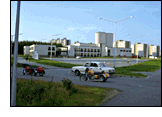 Sparre
remembers his night in Kostomuksha with Emil Wickström and
his guide from Kuhmo, Renne Haverinen: Sparre
remembers his night in Kostomuksha with Emil Wickström and
his guide from Kuhmo, Renne Haverinen:
In Vonkajärvi and other villages we were warned about
the people in Kostomuksha. They said it was a real den of thieves,
and these rumors were borne out by horrible stories of how travelers
to that village had mysteriously disappeared without a trace.
Thus far we have not paid much attention to these stories. But
when we compare them to the scene we just witnessed in the yard
of the house where the wedding was held, we concluded that just
about anything could happen tomorrow. At home we talked about
it for a long time and decided to take necessary precautions.
Renne locked the door and lay down to sleep in front of it. Fatigue
soon overcame fear, and he fell asleep in the middle of one of
our anecdotes. He then began snoring so loud the whole place shook.
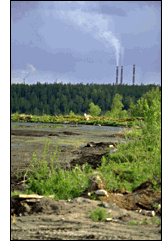 Iron Iron
The iron content of the Kostomuksha region has been well known
for a long time. A.J. Sjögren mentioned it in the 1820s:
I hear that the peasants in Kostomuksha make iron from ore
they find in the bogs. It is generally thought that the lakes,
too, have iron in them.
One of Karelia's best known writers, Jaakko Rugojev, is
a native of Kostamoksha. When the mining complex there was being
built, he appealed to the engineers to spare the beautiful lake
from becoming a sludge basin for the mines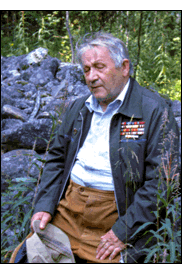 . His appeal fell on deaf ears but provided the engineers with more
work: it seems they neglected to plan retaining walls for the sludge
basin. The water would have flowed freely from Lake Kostomukshajärvi
and polluted the entire Lake Kuittijärvi watercourse, which
runs through the bardic regions. After fighting against the technocrats
and bureaucrats and ultimately writing to the highest government
levels in the Soviet Union, Rugojev realized a victory of sorts.
The mining complex was ordered to built a dam three kilometers long
and dozens of meters high and wide to prevent sludge from the mining
operations from polluting nearby waters.
. His appeal fell on deaf ears but provided the engineers with more
work: it seems they neglected to plan retaining walls for the sludge
basin. The water would have flowed freely from Lake Kostomukshajärvi
and polluted the entire Lake Kuittijärvi watercourse, which
runs through the bardic regions. After fighting against the technocrats
and bureaucrats and ultimately writing to the highest government
levels in the Soviet Union, Rugojev realized a victory of sorts.
The mining complex was ordered to built a dam three kilometers long
and dozens of meters high and wide to prevent sludge from the mining
operations from polluting nearby waters.
Kontokki and Kostamus
Audio sample
|
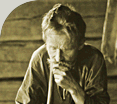
 At
the turn of the century, the municipality of Kontokki included Kostomuksha,
the villages around Lake Kiitehenjärvi, as well as the villages
of Vuokinsalmi, Saarijärvi and Niskajärvi near the Finnish
border. The eastern boundary of Kontokki extended beyond Lake Kenttijärvi.
The population of the municipality in 1907 was 1,872.
At
the turn of the century, the municipality of Kontokki included Kostomuksha,
the villages around Lake Kiitehenjärvi, as well as the villages
of Vuokinsalmi, Saarijärvi and Niskajärvi near the Finnish
border. The eastern boundary of Kontokki extended beyond Lake Kenttijärvi.
The population of the municipality in 1907 was 1,872.

 Inha
wrote the following about the graveyard in Kostomuksha, to which
he had compared that in Kontokki:
Inha
wrote the following about the graveyard in Kostomuksha, to which
he had compared that in Kontokki:
 Stroitša,
or Pentecost, was the traditional village festival (praznika)
in Kostomuksha. People came there from the surrounding villages,
and as Inha tells us, the neighboring village, Kontokki, did its
best to contribute to a festive atmosphere:
Stroitša,
or Pentecost, was the traditional village festival (praznika)
in Kostomuksha. People came there from the surrounding villages,
and as Inha tells us, the neighboring village, Kontokki, did its
best to contribute to a festive atmosphere:
 Sparre
remembers his night in Kostomuksha with Emil Wickström and
his guide from Kuhmo, Renne Haverinen:
Sparre
remembers his night in Kostomuksha with Emil Wickström and
his guide from Kuhmo, Renne Haverinen: Iron
Iron
 . His appeal fell on deaf ears but provided the engineers with more
work: it seems they neglected to plan retaining walls for the sludge
basin. The water would have flowed freely from Lake Kostomukshajärvi
and polluted the entire Lake Kuittijärvi watercourse, which
runs through the bardic regions. After fighting against the technocrats
and bureaucrats and ultimately writing to the highest government
levels in the Soviet Union, Rugojev realized a victory of sorts.
The mining complex was ordered to built a dam three kilometers long
and dozens of meters high and wide to prevent sludge from the mining
operations from polluting nearby waters.
. His appeal fell on deaf ears but provided the engineers with more
work: it seems they neglected to plan retaining walls for the sludge
basin. The water would have flowed freely from Lake Kostomukshajärvi
and polluted the entire Lake Kuittijärvi watercourse, which
runs through the bardic regions. After fighting against the technocrats
and bureaucrats and ultimately writing to the highest government
levels in the Soviet Union, Rugojev realized a victory of sorts.
The mining complex was ordered to built a dam three kilometers long
and dozens of meters high and wide to prevent sludge from the mining
operations from polluting nearby waters.